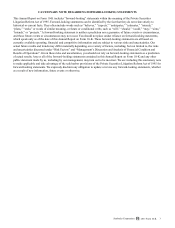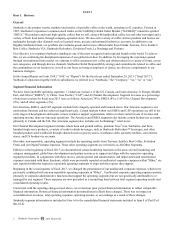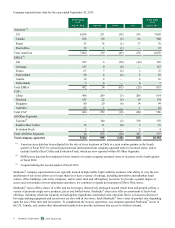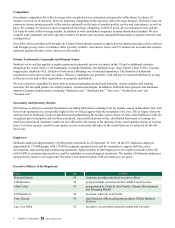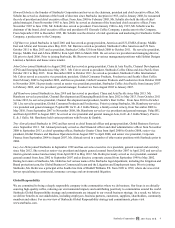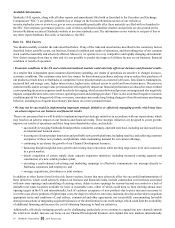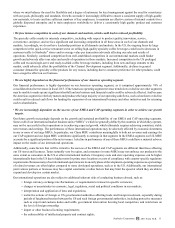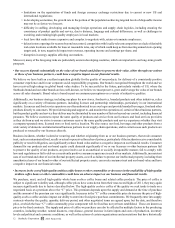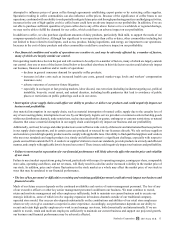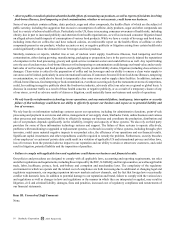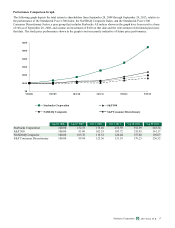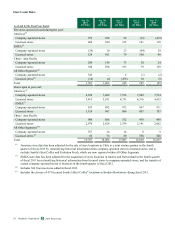Starbucks 2013 Annual Report Download - page 19
Download and view the complete annual report
Please find page 19 of the 2013 Starbucks annual report below. You can navigate through the pages in the report by either clicking on the pages listed below, or by using the keyword search tool below to find specific information within the annual report.
11
where we must balance the need for flexibility and a degree of autonomy for local management against the need for consistency
with our goals, philosophy and standards. Growth can make it increasingly difficult to ensure a consistent supply of high-quality
raw materials, to locate and hire sufficient numbers of key employees, to maintain an effective system of internal controls for a
globally dispersed enterprise and to train employees worldwide to deliver a consistently high quality product and customer
experience.
• We face intense competition in each of our channels and markets, which could lead to reduced profitability.
The specialty coffee market is intensely competitive, including with respect to product quality, innovation, service,
convenience, and price, and we face significant and increasing competition in all these areas in each of our channels and
markets. Accordingly, we do not have leadership positions in all channels and markets. In the US, the ongoing focus by large
competitors in the quick-service restaurant sector on selling high-quality specialty coffee beverages could lead to decreases in
customer traffic to Starbucks® stores and/or average value per transaction adversely affecting our sales and results of
operations. Similarly, continued competition from well-established competitors in our international markets could hinder
growth and adversely affect our sales and results of operations in those markets. Increased competition in the US packaged
coffee and tea and single-serve and ready-to-drink coffee beverage markets, including from new and large entrants to this
market, could adversely affect the profitability of the Channel Development segment. Additionally, declines in general
consumer demand for specialty coffee products for any reason, including due to consumer preference for other products, could
have a negative effect on our business.
• We are highly dependent on the financial performance of our Americas operating segment.
Our financial performance is highly dependent on our Americas operating segment, as it comprised approximately 74% of
consolidated total net revenues in fiscal 2013. If the Americas operating segment revenue trends slow or decline our other segments
may be unable to make up any significant shortfall and our business and financial results could be adversely affected. And because
the Americas segment is relatively mature and produces the large majority of our operating cash flows, such a slowdown or decline
could result in reduced cash flows for funding the expansion of our international business and other initiatives and for returning
cash to shareholders.
• We are increasingly dependent on the success of our EMEA and CAP operating segments in order to achieve our growth
targets.
Our future growth increasingly depends on the growth and sustained profitability of our EMEA and CAP operating segments.
Some or all of our international market business units (“MBUs”), which we generally define by the countries in which they operate,
may not be successful in their operations or in achieving expected growth, which ultimately requires achieving consistent, stable
net revenues and earnings. The performance of these international operations may be adversely affected by economic downturns
in one or more of our large MBUs. In particular, our China MBU contributes meaningfully to both net revenues and earnings for
our CAP segment and our Japan MBU contributes significantly to earnings in that segment. In the EMEA segment, our UK MBU
accounts for a significant portion of the net revenues. A decline in performance of any of these MBUs could have a material adverse
impact on the results of our international operations.
Additionally, some factors that will be critical to the success of the EMEA and CAP segments are different than those affecting
our US stores and licensees. Tastes naturally vary by region, and consumers in some MBUs may not embrace our products to the
same extent as consumers in the US or other international markets. Occupancy costs and store operating expenses can be higher
internationally than in the US due to higher rents for prime store locations or costs of compliance with country-specific regulatory
requirements. Because many of our international operations are in an early phase of development, operating expenses as a percentage
of related revenues are often higher compared to more developed operations, such as in the US. Additionally, our international
joint venture partners or licensees may face capital constraints or other factors that may limit the speed at which they are able to
expand and develop in a certain market.
Our international operations are also subject to additional inherent risks of conducting business abroad, such as:
• foreign currency exchange rate fluctuations, or requirements to transact in specific currencies;
• changes or uncertainties in economic, legal, regulatory, social and political conditions in our markets;
• interpretation and application of laws and regulations;
• restrictive actions of foreign or US governmental authorities affecting trade and foreign investment, especially during
periods of heightened tension between the US and such foreign governmental authorities, including protective measures
such as export and customs duties and tariffs, government intervention favoring local competitors, and restrictions on
the level of foreign ownership;
• import or other business licensing requirements;
• the enforceability of intellectual property and contract rights;
2013 10-K
Starbucks Corporation Form


